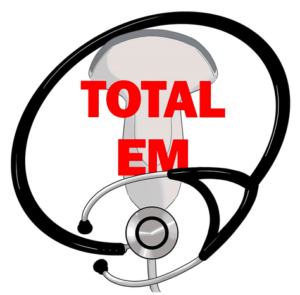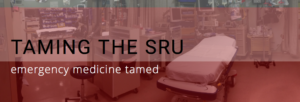Nursing FOAMed Review #13 – September 2019
Total EM podcast #166 is all about patients with PICC lines, and the possible complications that you may face in the ED when presented with these patients. I don’t get a lot of PICC line patients in my ED – but this was a great review and refresher. Listen if you want to know what to do when your PICC won’t flush, if you can’t remember what syringe sizes you want to use, need to know what to do with leaking or bleeding PICCs and what to do when you suspect infection.
Taming the SRU has released a small article concerning syncope in the ED. In case you were wondering if this is something we all struggle with, the answer is a resounding “yes”. Are there diagnostic or prognostic criteria rules that can be applied that can help us decide who needs imaging, PE work-up, and admission? This article reviews the differences between the San Francisco Syncope Rule and the Canadian Syncope Risk Score and even considers just good ol’ physician gestalt. Nothing in this article is groundbreaking – but it is a good review and gives a window into the soul of the physician who is trying to decide what the hell to do with your chief complain “syncope” patient with no other presenting symptoms.
Christopher Winstead-Derlega writes in EMDocs about CHS, or Cannabinoid Hyperemesis Syndrome. I get to see a lot of this in my ED, but I just had a conversation with a nurse in Southern Oregon who sees way more. While the best treatment for CHS is known to be total cessation of cannabinoid substances containing THC, the acute phase of the disease, and the lack of common sense and obvious idiocy of the patient population, makes this a difficult disease to ignore in the ED. The loud full-body wretching is a distraction in any environment, and prolonged fluid depletion can actually make the acute patient high on any triage scale. Read the article for treatment protocol and a great dive into the pathophysiology of the disease. Take a look to learn about the “TRPV1 receptor (transient receptor potential vanilloid subtype 1), which is activated by marijuana, capsaicin and heat, is altered by chronic marijuana use, and [may be] responsible for CHS”
Brit Long gives us a great review of Myasthenia Gravis – pathophysiology, presentation, bedside differential, treatment, and even a link to Josh Farkas’ IBCC chapter on the disease are all included within. There are fantastic pearls within.
- Learn about the “20 word test” and why pulmonary function tests may not influence your decision to intubate or not.
- Why medication lists and autonomic dysfunction may point to a different acute dx on your MG patient presenting in acute distress.
- Why a neuro exam and memorizing SLUDGEMM are important during your bedside exam.
- Learn about the “ice pack test” and it’s 90% sensitivity.
One of the things I thought was really interesting about this article was the “treatment” section – it obviously talked about the need for NIPPV, IVIG and plasmapheresis and the obvious neuro consult, but it conspicuously left out mention of Pyridostigmine. Go to Farkas’ section on this cornerstone treatment for MG in the IBCC already hyperlinked above.
Thinking Critical Care brings us as a lecture from Segun Olusanya concerning Cardiogenic Shock. This is another video found through YouTube from the “Hospitalist and Resuscitationist” conference in May of 2019. Honestly there are some fantastic lectures in this collection, so do yourself a favor and grab a bottle of wine and start watching some more YouTube videos. This lecture is a bit tough to listen to – Dr. Olusanya tends to mumble and speak incredibly fast – but it is worth the occasional rewind, I think. My favorite part of this lecture is the usage the table linked below. How this table is utilized bedside, and how that presentation is then treated based off the position of the patient within this table is pretty fascinating to me. I love any tool that can take critical complex patients and then aid in the simplification of treatment pathways. Take a look at the table and listen to the lecture. 20 minutes of well spent time!
Ryan Radecki from Emergency Medicine Literature of Note always brings us great dogmalysis in Emergency medicine. In this particular piece he shows us the science behind the often repeated mantra of “grab the cultures before the antibiotics”. It’s a pretty simple bit of writing but it’s great. Why repeat dogma when you can truly understand the science behind it? Simply put – before the antibiotics positive cultures = approx. 31%. After the antibiotics = less than 20%. So as Ryan points out here – if you are going through all the trouble of pulling the cultures, you might as well do it before the abx.
ALIEM delivers in September with my favorite bit of FOAMed for the month. Maybe it is because I was a tech for so long and have had so many difficult ultrasound IV “sticks”, or maybe it is just because I think this article is so incredibly well put together – but either way, this review on ultrasound guided IV placement by doctors Kimon Ioannides and Ryan Gibbons is going into my personal “all time favorites pile”. so if you want to know how to better find veins, get that needle tip into the proper spot, and advance that catheter into some tight and tough spots, read this article. I know I’m going to be sharing the hell out of this one.
CORE EM has a great clinical and pathophysiology review for AKA. I honestly haven’t even thought of alcoholic ketoacidosis since I first read about it a few years ago – so it was great to have the refresher. I think with all the DKA we see in EDs, it is easy to forget about AKA – but I know I’ll have it high on the differential list from no won with my known ETOH abusers who appear to have worse than normal labs. I have probably seen a few of these patients in the past couple of years and just not been able to recall this unifying diagnosis for someone who presents with a large anion gap, hypomagnesemia, hypokalemia and acidosis. There are some great review points in this article to include:
- pointers on what to fix first – potassium or glucose?
- how and why to fix electrolyte abnormalities and vitamin deficiencies
- the possible increased risk of mortality in AKA patients
R.E.B.E.L. EM’s Mark Ramzy writes about the first study of its kind comparing 30 day survival of critically sick patients that had critical care initiated in an ED-ICU. The original article comments on a retrospective analysis of critically sick patients that were identified and had ICU level care initiated while in the ED in a separate hybrid ED-ICU located within the ED itself. This ED-ICU is separately staffed, prepared for the sickest emergent patients and equipped specifically for ICU level care, even though it is located in the ED. Long story short – the study finds that if you identify sick patients quickly, provide them with ICU level care immediately, and have proper ICU level staffing for patients requiring intense resuscitation – you guessed it – survival rates go up. This article has been getting a lot of pod-cast time and FOAMed ink – and I believe that it deserves it. I’m hoping that this is the future of big Level-1 EDs across the country. For anyone who has ever worked in an understaffed ED, and had ridiculously unsafe patient to nurse ratios – we all know that our ICU boarders don’t get the level of care they require.
Nickolas Caputo writes about ET02 and pre-intubation oxygenation in another article from R.E.B.E.L. EM. I’d never heard of ET02 before, but I guess if you know what ETCO2 is, then you can figure out what ET02 is. A few interesting things about the original article hyperlinked here – one is that this study shows that pre-oxygenation is shown to be most effective with an NRB at flush rate (basically put the NRB on and crank it up way past the 15 lpm mark). Another is how few patients actually reached the 85% mark for their exhaled 02. An interesting take on another way for us to be monitoring our pre-oxygenation technique and hopefully getting to even fewer post intubation hypoxic injuries.
David Slessor writes for The Bottom Line about the AVERT-Shock trial published in JAMA surgery in late August. For anyone working in a trauma bay this article is quite interesting. Next time you que up the MTP remember that TXA isn’t the only thing that should be on your mind. This authors of AVERT-Shock found that low dose Vasopressin decreased the amount of blood needed to be transfused for bleeding patients, while not contributing to significant side effects. The Bottom Line and other FOAMed bloggers are quick to point out that the findings need to be confirmed in a prospective multi-center trial before application into practice, but the findings are exciting and if the findings ever begin to effect common practice, you’ll be ahead of the curve.









